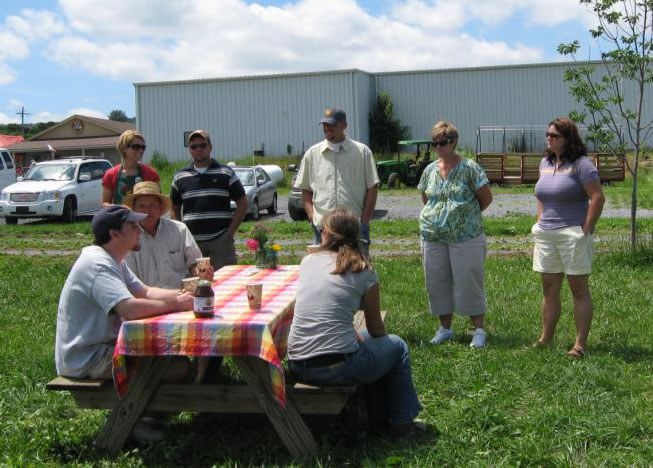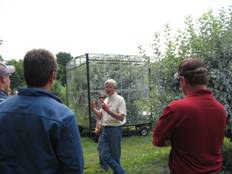June 17, 2009 in Kearneysville and Martinsburg, WV
In June, the Young Grower Alliance embarked on an all-day journey to West Virginia to tour the USDA Appalachian Fruit Research Station as well as Orr's Farm Market and Orchards. The purpose of the field trip was two-fold: to give the researchers from the Fruit Research Station direct accessibility to young growers in order to share their newest discoveries and innovations in agriculture, and to expose the young growers to new technologies and business ventures (found at Orr's Family Farm) in order to encourage future innovations. It was a great educational opportunity for YGA members and it attracted a dozen young farmers from Pennsylvania, Maryland, and Connecticut.
Young Growers Visit Appalachian Fruit Research Station and Orr's Orchards in West Virginia
Amelia Jarvinen, Penn State Ag Innovations Program Assistant
In June, the Young Grower Alliance embarked on an all-day journey to West Virginia to tour the USDA Appalachian Fruit Research Station as well as Orr's Farm Market and Orchards. The purpose of the field trip was two-fold: to give the researchers from the Fruit Research Station direct accessibility to young growers in order to share their newest discoveries and innovations in agriculture, and to expose the young growers to new technologies and business ventures (found at Orr's Family Farm) in order to encourage future innovations. It was a great educational opportunity for YGA members and it attracted a dozen young farmers from Pennsylvania, Maryland, and Connecticut.
The Appalachian Fruit Research Station provided interesting insight into the recent developments in research concerning tree architecture, tree breeding, and tree productivity, as well as presenting new and updated mechanized thinning machines and information regarding their use and efficiency.
Mike Glenn, the Director of the research station and a soil scientist, acted as tour guide. He introduced the USDA Appalachian Fruit Research Station with general information about the facility as well as presenting his own research project to the group. "The Appalachian Fruit Research Station is a federal facility that works on a national level. The employees here are concerned with identifying the limiting factors of tree fruit growth. To address this, they work on the fundamental subjects of agriculture: plant biology, soil science, and every other subject across the gambit." He added that, "the research station employs 17 scientists and operates on 550 acres where they are able to grow unique plants and conduct unique experiments, sometimes creating plants that are one-of-a-kind."
The tour covered much ground, winding through corridors and peeking into impressive greenhouses. The group stopped at several stations where leading scientists gave presentations about their most recent work.

Tom Tworkoski, one of the premier plant physiologists at the research center, gave some fresh insights into tree design. His research concerns "the manipulation of tree architecture for optimal growth." He emphasized tree branching as being central to optimal tree growth because it dictates many aspects of tree physiology such as the amount of pruning needed, precocity, and mechanization.
The senior engineering technician, Scott Wolford, gave an impressive presentation about the developing technologies of mechanical harvesters and thinners. "There's a five-year turnaround from thought and design to the creation of a prototype for these machines." He was extremely enthusiastic about mechanical performance and proudly boasted that "new citrus harvest machines cut the cost of harvesting fruit by half because they are more efficient than human labor. They can pick about 7 truckloads of fruit in a day."
Other presentations covered research dealing with tree resistance to fire blight and other serious diseases, as well as experiments concerning the sex pheromones of insects and the disruption of insect mating. The research that was covered in the tour was extremely relevant to addressing the problems that producers face today. "It was very reassuring to see those scientists working on such pertinent subjects; it seems that some of the problems of farming today will be nonexistent tomorrow, thanks to their research," commented Rusty Lamb who manages Kuhn's Orchard in Cashtown.
The young growers were very impressed by each scientist's presentation and learned intimate information concerning recent developments in agricultural research and technology.
After touring the USDA Appalachian Fruit Research Station in Kearneysville, West Virginia, the group made its way to Orr's Farm Market and Orchards in Martinsburg, West Virginia. Upon first inspection, the Orr family farm was impressively large, spanning hundreds of acres with variety upon variety of fruits and vegetables.
Orr's Family Farm is a highly diverse and intricately planned business. It boasts such ventures as pick-your-own fruit crops (which is a growing business in the agri-tourism industry), fruit packing (complete with modern storage facilities), and the operation of an on-site bakery. The Orr family started by growing fruit for the wholesale market and is gradually marketing more produce directly to local consumers.
"The visit to Orr's Farm was very insightful and it gave me some ideas for my own farm," said Russell Holmberg, a young grower from Connecticut, "their operation is very impressive." Impressive indeed; apart from operating a multi-faceted business, the Orr family grows a wide-ranging assortment of fruit varieties. "We grow 17 different varieties of plums alone, not to even mention the number of apple varieties we grow here," says Mike Orr, co-owner of the farm and sales manager.

Yields are very impressive on the Great Limestone Valley soils. The apple orchards average between 800 and 900 bushels per acre, and Golden Delicious have yielded 2000 bushels per acre. To pick the fruit, they employ 40 people during peach harvest season and 75 during apple harvest. "They are an extremely innovative operation. Seeing their farm as a model was very informative and thought-provoking," said Ben Keim, a young grower from Berks County.
At the end of the day, the group of young specialty crop growers seemed satisfied with the information they had learned. The USDA Appalachian Fruit Research Station had provided information about the future of agriculture, while Orr's Farm Market and Orchards provided a model for a successful and innovative farm operation.
The Young Grower Alliance is dedicated to providing horticultural education to its 135 (and growing) members. It brings together producers from all over North America to communicate shared experiences and innovative agriculture methods. Its main goal is to "encourage, develop, support, and equip the next generation of specialty crop growers" through field trips and direct exposure to new practices and technologies.
Contact us

Social Media
Contact us



